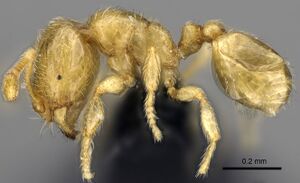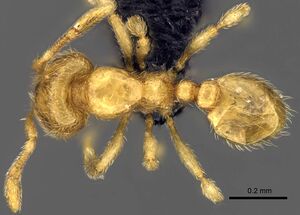Carebara malagasy
| Carebara malagasy | |
|---|---|

| |
| Scientific classification | |
| Kingdom: | Animalia |
| Phylum: | Arthropoda |
| Class: | Insecta |
| Order: | Hymenoptera |
| Family: | Formicidae |
| Subfamily: | Myrmicinae |
| Tribe: | Crematogastrini |
| Genus: | Carebara |
| Species: | C. malagasy |
| Binomial name | |
| Carebara malagasy Azorsa & Fisher, 2018 | |
Carebara malagasy has been found in littoral rainforest and tropical dry forest and collected at elevations ranging from 25 m to 500 m. Individuals and colonies were found under stones, in leaf mold and rotten wood. Specimens were collected using maxi-Winkler and pitfall traps.
Identification
Azorsa & Fisher (2018) - Antennae ten-segmented. Major: Head subrectangular, longer than wide, lateral margins weakly convex and narrowed at the top, posterolateral corners well developed, posterior margin of head deeply concave; dorsum of propodeum convex, posterodorsal corner angulate; gaster with short decumbent hairs and sparse longer subdecumbent hairs. Minor: Head slightly longer than wide, promesonotum weakly convex; dorsum of propodeum convex, posterodorsal corner angulate; gaster with short decumbent hairs, and sparse longer subdecumbent hairs.
Carebara malagasy can be separated from other species by the following combination of characters: form of the propodeum, which is unarmed or armed with at least a dentiform angle, dorsum of head with at least the frons smooth and shiny, and posterolateral corners of head narrowing posteriorly. Carebara malagasy is endemic to the north of Madagascar, and five other species were recorded at this area: Carebara bara, Carebara berivelo, Carebara grandidieri, Carebara kabosy, and Carebara tana.
C. malagasy have two intermediates in the major worker subcaste. The posterolateral corner of head in both intermediates is slightly narrowed posteriorly. The posterior margin of the head is deeply concave. The eyes are small and reduced to one ommatidium in intermediate 1, and up to 5 ommatidia in intermediate 2. Ocelli are absent in intermediate 1, but present and well developed in intermediate 2 (one ocellus). Reduced flight sclerites are present in intermediate 2. The dorsum of the promesonotum is high and nearly rounded in intermediate 1, and convex in intermediate 2. In both intermediates, the shapes of the petiole and postpetiole are similar; the propodeum is unarmed; the head is smooth and shiny, with finely longitudinal and parallel rugae; and the pilosity on the head and body follows the same pattern.
Keys including this Species
Distribution
Azorsa and Fisher (2018) - Northern Madagascar.
Latitudinal Distribution Pattern
Latitudinal Range: -12.09949° to -18.91813°.
| North Temperate |
North Subtropical |
Tropical | South Subtropical |
South Temperate |
- Source: AntMaps
Distribution based on Regional Taxon Lists
Malagasy Region: Madagascar (type locality).
Distribution based on AntMaps
Distribution based on AntWeb specimens
Check data from AntWeb
Countries Occupied
| Number of countries occupied by this species based on AntWiki Regional Taxon Lists. In general, fewer countries occupied indicates a narrower range, while more countries indicates a more widespread species. |

|
Estimated Abundance
| Relative abundance based on number of AntMaps records per species (this species within the purple bar). Fewer records (to the left) indicates a less abundant/encountered species while more records (to the right) indicates more abundant/encountered species. |

|
Biology
Castes
Worker
Images from AntWeb
   
| |
| Paratype of Carebara malagasy. Worker. Specimen code casent0044172. Photographer Frank Azorsa, uploaded by California Academy of Sciences. | Owned by CAS, San Francisco, CA, USA. |
Nomenclature
The following information is derived from Barry Bolton's Online Catalogue of the Ants of the World.
- malagasy. Carebara malagasy Azorsa & Fisher, 2018: 97, figs. 50, 51, 69 (s.w.) MADAGASCAR.
- Type-material: holotype major worker, 4 paratype major workers, 16 paratype minor workers.
- Type-locality: holotype Madagascar: Antsiranana, Forèt de Bekaraoka, 6.8 km. 60° ENE Daraina, -13.16667, 49.71, 150 m., 7.xii.2003, BLF09872, tropica dry forest (B.L. Fisher); paratypes with same data.
- Type-depositories: CASC (holotype); BMNH, CASC, MCZC, MHNG, NHMB (paratypes).
- Distribution: Madagascar.
Unless otherwise noted the text for the remainder of this section is reported from the publication that includes the original description.
Description
Worker
Major. (n=16): HL 0.56–1.02 (0.75); HW 0.46–0.80 (0.59); SL 0.25–0.37 (0.28); ML 0.13–0.27 (0.18); EL 0.01–0.05 (0.01); EM 0.14–0.30 (0.22); HD 0.30–0.59 (0.41); WL 0.48–0.91 (0.62); PSL 0.04–0.10 (0.05); PW 0.28–0.55 (0.38); MFL 0.27–0.53 (0.36); MFW 0.06–0.12 (0.07); MTL 0.19–0.45 (0.26); PTL 0.17–0.36 (0.25); PNL 0.08–0.14 (0.10); PTH 0.13–0.25 (0.18); PTW 0.12–0.23 (0.15); PPL 0.11–0.20 (0.14); PPNL 0.10–0.20 (0.12); PPH 0.11–0.25 (0.15); PPW 0.16–0.32 (0.20); GL 0.38–1.15 (0.62); GW 0.39–0.94 (0.57); CI 73–83 (79); MI 20–26 (24); SI 35–69 (37); MLI 58–69 (61); PPLI 55–71 (56); PPI 129–150 (133); PSI 8–13 (8).
Head longer than wide (CI 73–83), in full-face view nearly subrectangular, about 1.2 times longer than wide, narrowed at the top. Posterior margin of head deeply concave, posterolateral corners well developed and rounded, lateral margins weakly convex. Mandibles with six teeth. Anterior margin of clypeus slightly concave, and laterally convex. Ocelli present or absent. Antennae with ten segments. Scapes short (HL 0.56–1.02, SL 0.25–0.37, SI 35–69). Eyes present, consisting of one ommatidium (EL 0.01–0.05). Supraclypeal area short and triangular, but shallowly impressed.
In profile, promesonotum high and nearly rounded, metanotal groove deeply impressed. Propodeum lower than promesonotum, and about 1.6 times higher than long, dorsal face of propodeum weakly convex and declining posteriorly, propodeum unarmed, anterodorsal corner rounded, posterodorsal corner angulate, declivity weakly concave. Propodeal lobes convex. Propodeal spiracle nearly oval and situated above mid-height of sclerite, and beyond mid-length of sclerite by about half the diameter of the spiracle, distance from propodeal spiracle to posterodorsal corner of propodeum about twice the diameter of the spiracle (PSL 0.04–0.10), and distance to declivity about 1.5 times the diameter of the spiracle. In dorsal view, promesonotum about as long as wide, narrowed posteriorly, anterior margin and sides of promesonotum rounded; sides of propodeum straight.
Petiole longer than high (PTL 0.17–0.36, PTH 0.13–0.25) and with relatively long peduncle, ventral face slightly convex in the middle. Combined outline of dorsal surface of peduncle and anterior face of node concave, posterior face of node vertical and nearly straight, anterodorsal corner convex, posterodorsal corner rounded, dorsum convex. Subpetiolar process produced as denticle, slightly larger than the diameter of the propodeal spiracle. Postpetiolar node nearly rounded and lower than petiolar node. In dorsal view, postpetiolar node wider than petiolar node (PTW 0.12–0.23, PPW 0.16–0.32) and petiolar node wider than long (PNL 0.08–0.14, PTW 0.12–0.23), anterior and posterior margins of petiole and postpetiole nearly straight, sides convex in petiole and nearly rounded in postpetiole.
Dorsal surface of mandibles, clypeus, supraclypeal area and frons smooth and shiny, with scattered piligerous punctae on head and mandibles. Head with finely longitudinal rugae directed toward posterior margin of head. Gena and frontal lobes with longitudinal rugae. Mesosoma smooth and shiny, except for katepisternum (areolate-rugose) and metapleuron (areolate with longitudinal rugae). Petiole and ventral face of postpetiole areolate. In dorsal view, mesosoma, petiole, postpetiole and gaster smooth and shiny.
Lateral margins and posterior margin of head with short subdecumbent hairs and longer suberect hairs. Scapes with appressed hairs. Outer margin of mandible with short and appressed hairs. Mesosoma with short and long suberect hairs. Petiole and postpetiole with short decumbent to appressed hairs and long subdecumbent hairs. Tibia with appressed hairs. Gaster with short decumbent hairs, and long suberect to subdecumbent hairs. Color yellowish ferruginous.
Minor. (n=15): HL 0.33–0.37; HW 0.29–0.33; SL 0.19–0.24; ML 0.08–0.09; EL 0.01–0.02; EM 0.09–0.12; HD 0.19– 0.22; WL 0.33–0.37; PSL 0.02–0.04; PW 0.17–0.20; MFL 0.19–0.25; MFW 0.04– 0.06; MTL 0.14–0.18; PTL 0.11–0.14; PNL 0.06–0.07; PTH 0.09–0.10; PTW 0.07–0.08; PPL 0.07–0.08; PPNL 0.06–0.08; PPH 0.06–0.08; PPW 0.10–0.12; GL 0.26–0.34; GW 0.21–0.28; CI 86–94; MI 22–26; SI 57–65; MLI 66–76; PPLI 54– 73; PPI 125–150; PSI 6–13.
Head longer than wide (CI 86–94), in full-face view nearly subrectangular, about 1.2 times longer than wide, slightly narrowed anteriorly. Posterior margin slightly convex, posterolateral corners rounded, lateral margins slightly convex. Mandibles with six teeth. Anterior margin of clypeus straight, and laterally with a laminate angulate tooth. Antennae with ten segments. Scape fails to reach the posterior margin of head (HL 0.33–0.37, SL 0.19–0.24, SI 57–65). Eyes present, consisting of one ommatidium (EL 0.01–0.02). Supraclypeal area short and triangular but poorly defined.
In profile view, promesonotum weakly convex, metanotal groove weakly impressed. Propodeum about 1.6 times higher than long, dorsal face of propodeum slightly convex and declining posteriorly, propodeum unarmed, anterodorsal corner slightly convex, posterodorsal corner angulate, declivity nearly flat, with thin lateral laminae. Propodeal lobes convex. Propodeal spiracle rounded and situated slightly above mid-height of sclerite by about half the diameter of the spiracle, and beyond mid-length of sclerite by about 1.5 times the diameter of the spiracle, distance from propodeal spiracle to postedorsal corner of propodeum and to declivity almost the same as the diameter of the spiracle (PSL 0.02–0.04). In dorsal view, promesonotum about 1.1 times longer than wide, anterior margin and sides of promesonotum nearly rounded, and narrowed posteriorly; sides of propodeum weakly convex.
Petiole slightly longer than high (PTL 0.11–0.14, PTH 0.09–0.10) and with a short peduncle, ventral face medially convex. Combined outline of dorsal surface of peduncle and anterior face of node weakly concave, posterior face of node slightly convex, anterodorsal and posterodorsal corner rounded, dorsum convex. Subpetiolar process produced as a small denticle, slightly smaller than the diameter of the propodeal spiracle. Postpetiolar node nearly rounded and lower than petiolar node. In dorsal view, postpetiolar node wider than petiolar node (PTW 0.07–0.08, PPW 0.10–0.12), and petiolar node wider than long (PNL 0.06–0.07, PTW 0.07–0.08), anterior and posterior margins of petiole and postpetiole nearly straight, sides nearly rounded in petiole and postpetiole.
Dorsal surface of head, mandibles, clypeus and supraclypeal area smooth and shiny, with scattered piligerous punctae on head and mandibles. Gena and frontal lobes with short longitudinal rugae. Mesosoma smooth and shiny, except for katepisternum (areolate) and metapleuron (finely areolate-rugose). Petiole and ventral face of postpetiole areolate. In dorsal view, promesonotum, postpetiole and gaster smooth and shiny, except for propodeum and petiole which are weakly areolate.
Lateral margins and posterior margin of head with decumbent hairs. Scapes with appressed hairs. Outer margin of mandible with decumbent hairs. Mesosoma with short and long suberect to subdecumbent hairs. Petiole, and postpetiole with short decumbent hairs and longer subdecumbent hairs. Tibia with appressed hairs. Gaster with short de-cumbent hairs and sparse long subdecumbent hairs. Color yellowish ferruginous.
Type Material
Holotype. (major worker), Madagascar, Antsiranana, Forêt de Bekaraoka, 6.8km 60° ENE Daraina, -13.16667, 49.71, 150 m, tropical dry forest, 7.xii.2003, (B.L. Fisher). Collection code BLF09872, (California Academy of Sciences: CASENT0044166). Paratypes: (4 major workers and 16 minor workers), with same data as holotype, 4 major workers (The Natural History Museum: CASENT0044178, CASC: CASENT0044274, CASENT0044173, CASENT0044169), and 16 minor workers (BMNH: CASENT0044161, CASC: CASENT0044167, CASENT0044168, CASENT0044275, CASENT0044165, CASENT0044179, CASENT0044175, CASENT0044174, CASENT0044162, CASENT0044176, CASENT0044277, CASENT0044276, CASENT0044180, Museum of Comparative Zoology: CASENT0044172, Musee d'Histoire Naturelle Genève: CASENT0044163, Naturhistorisches Museum, Basel: CASENT0044177).

